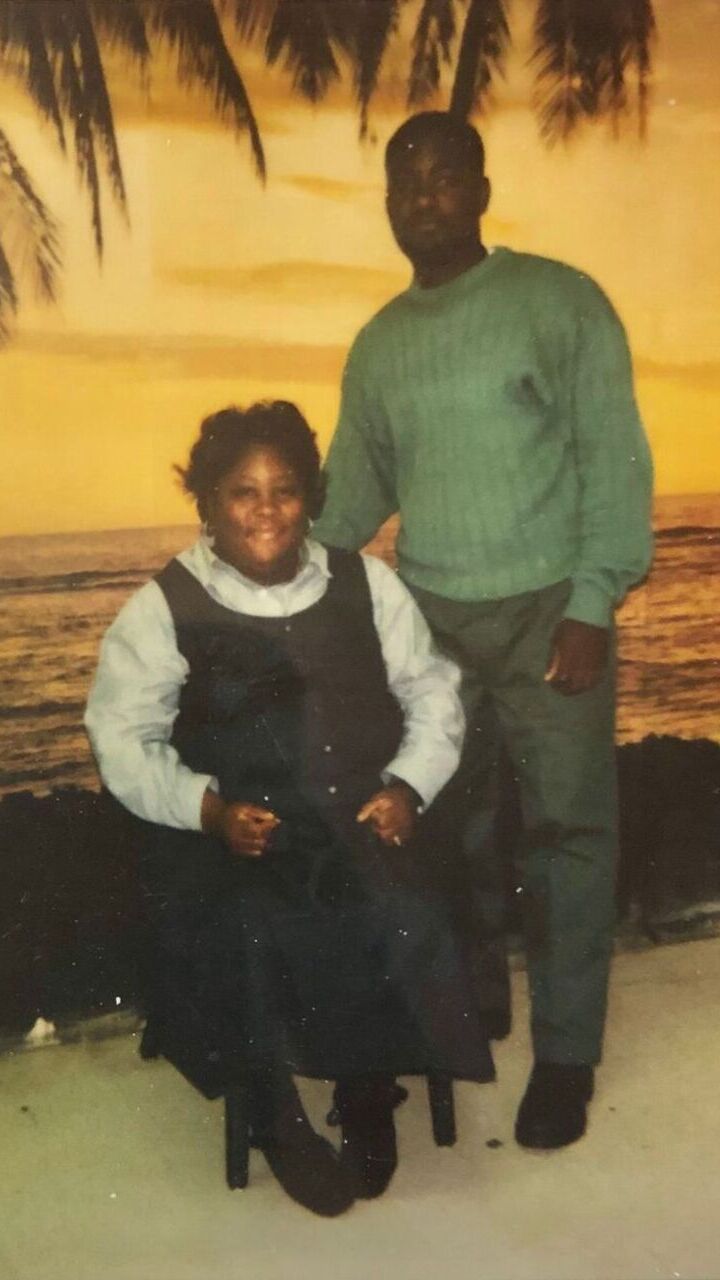
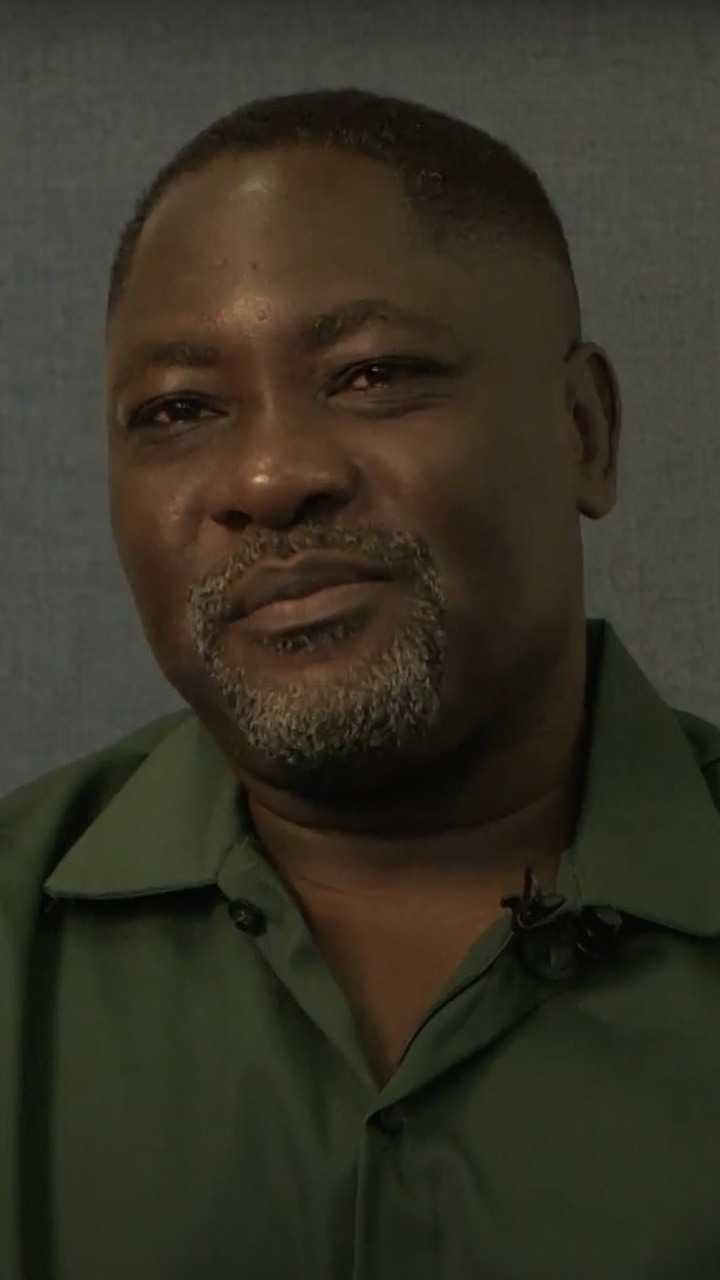
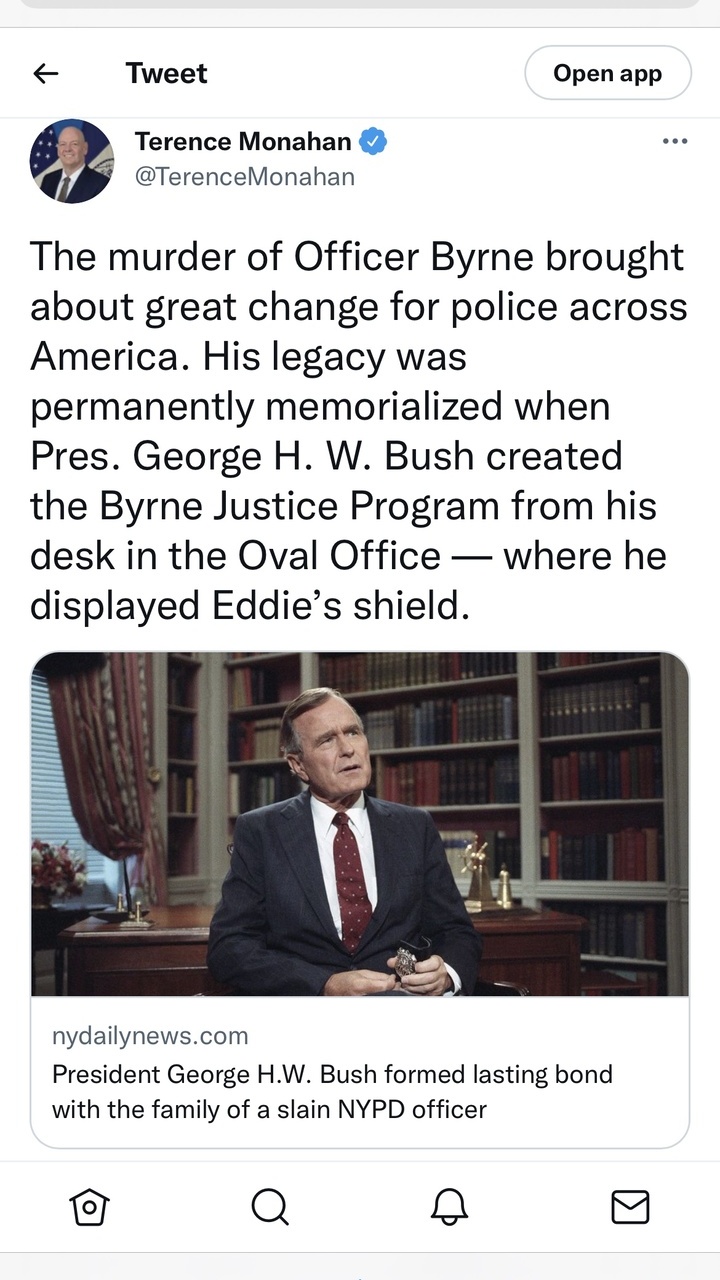

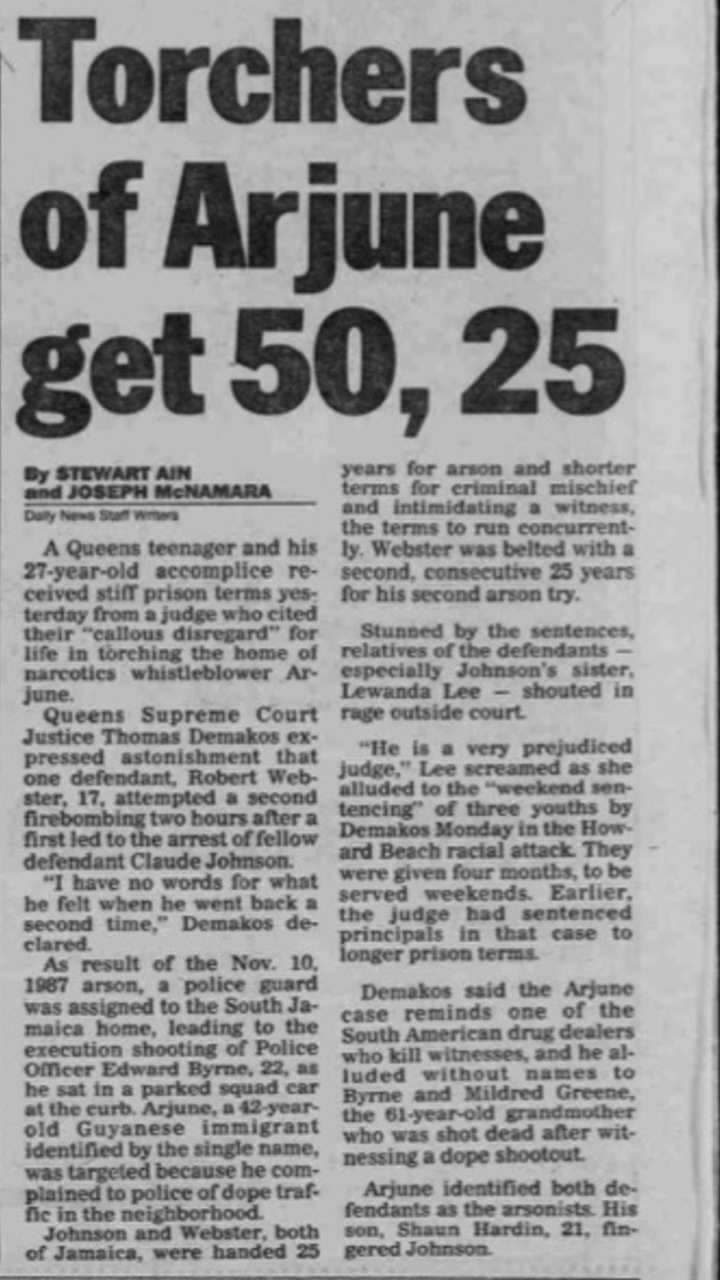
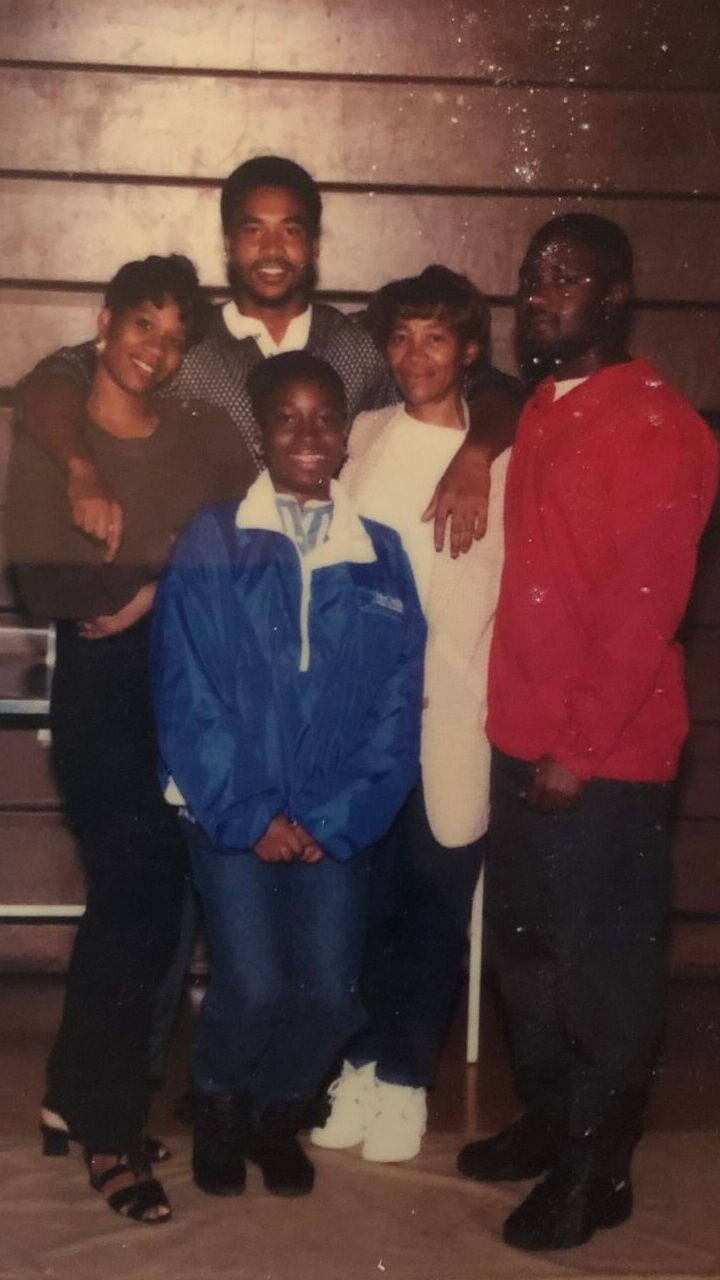
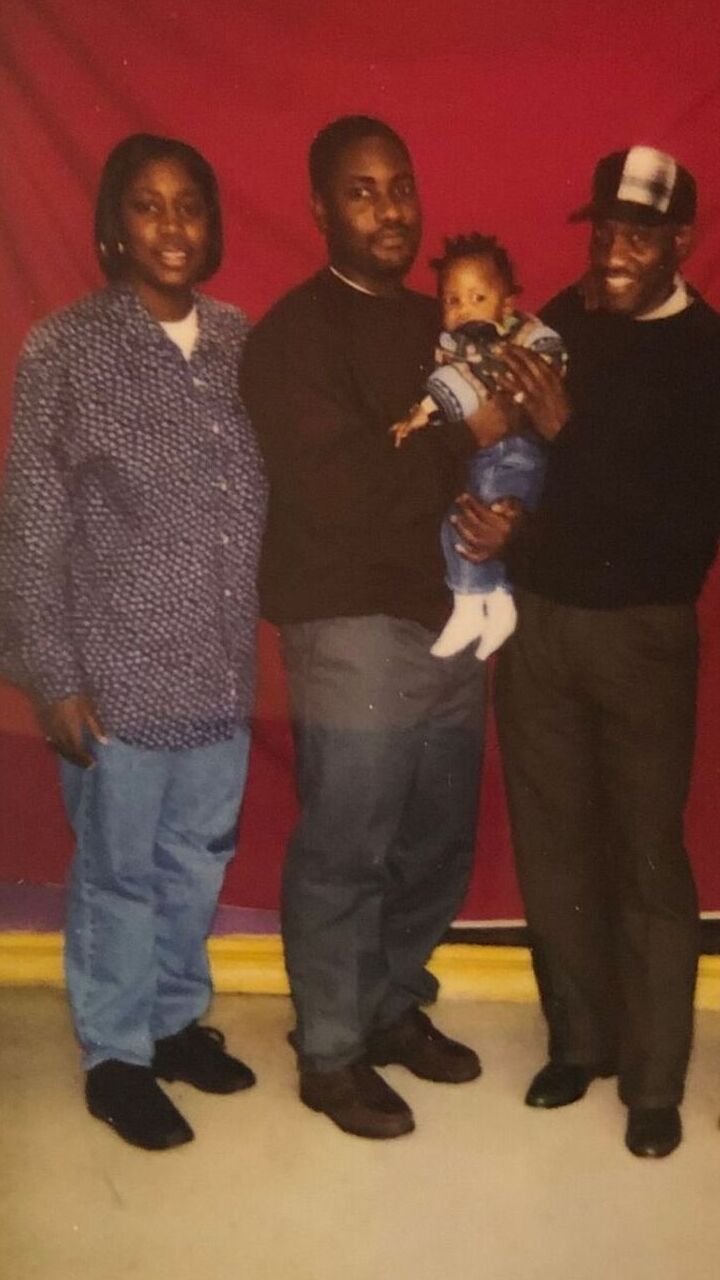
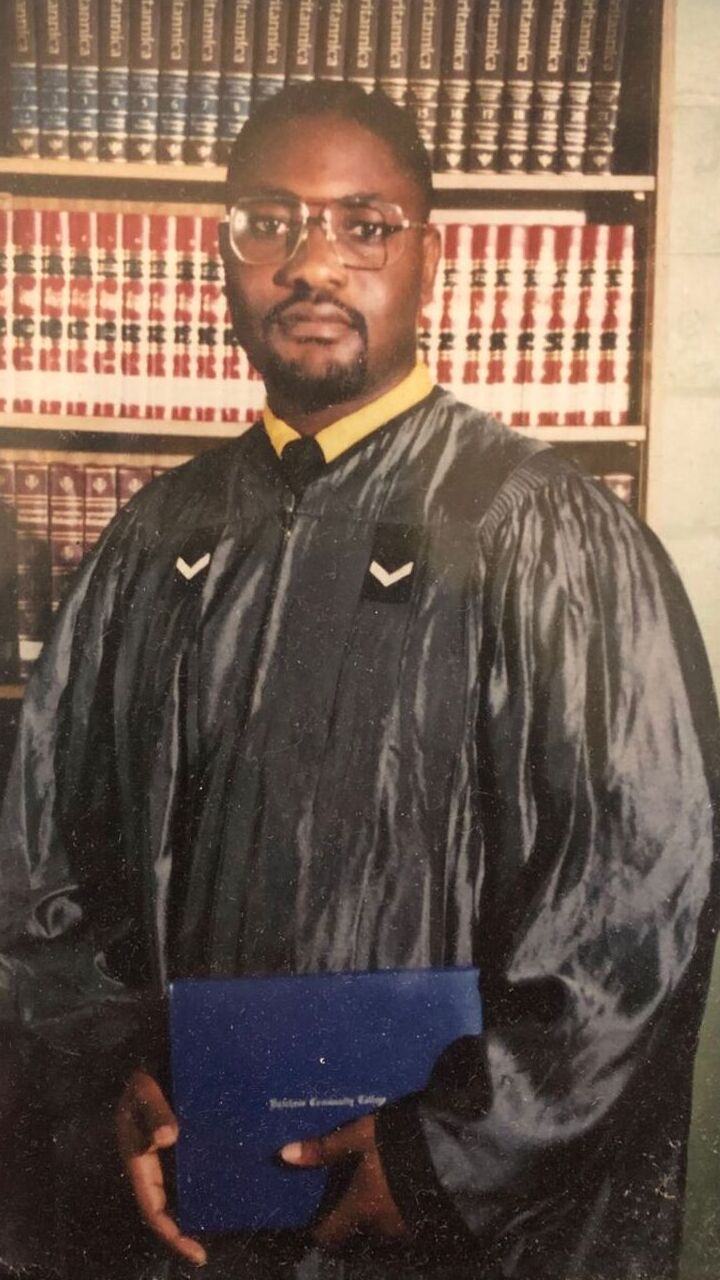
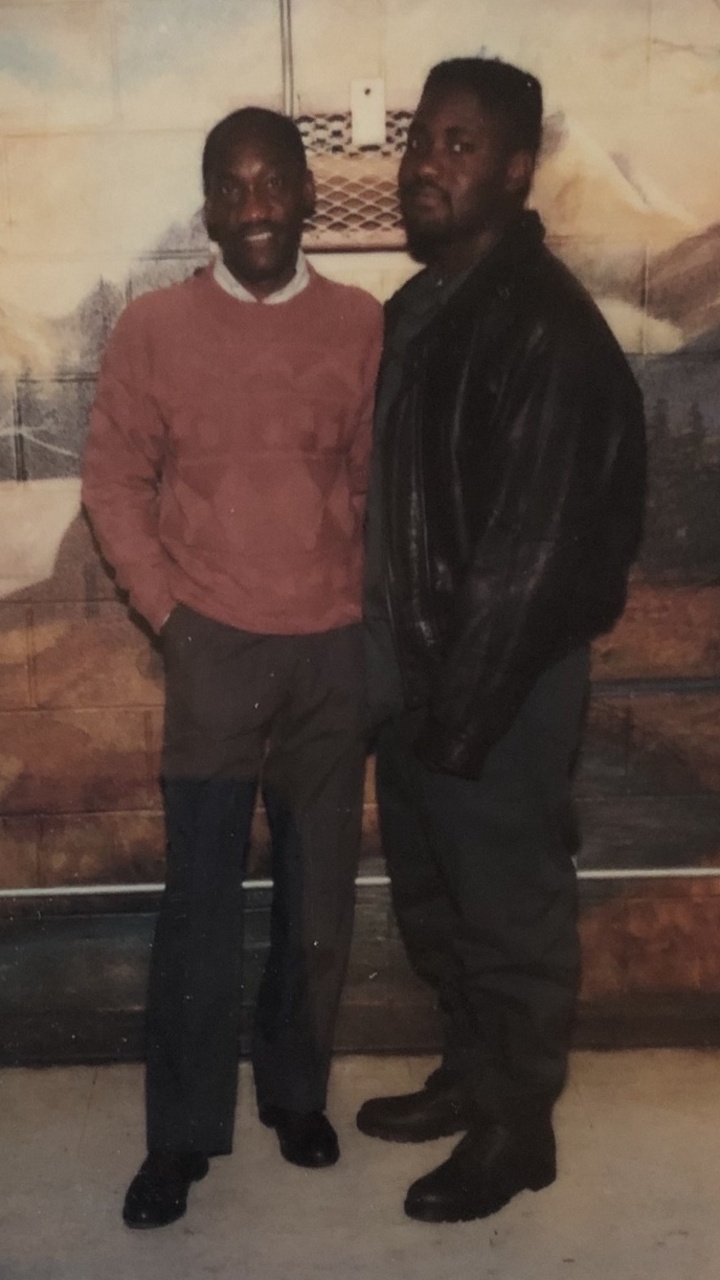

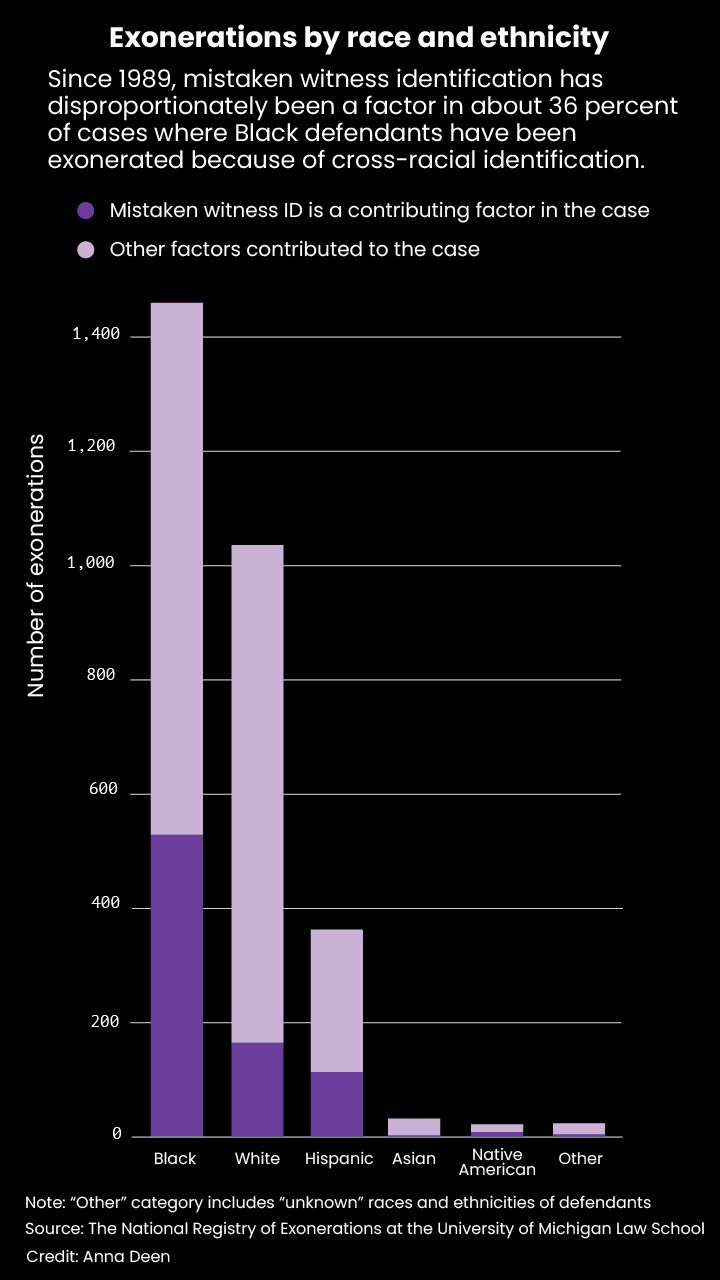
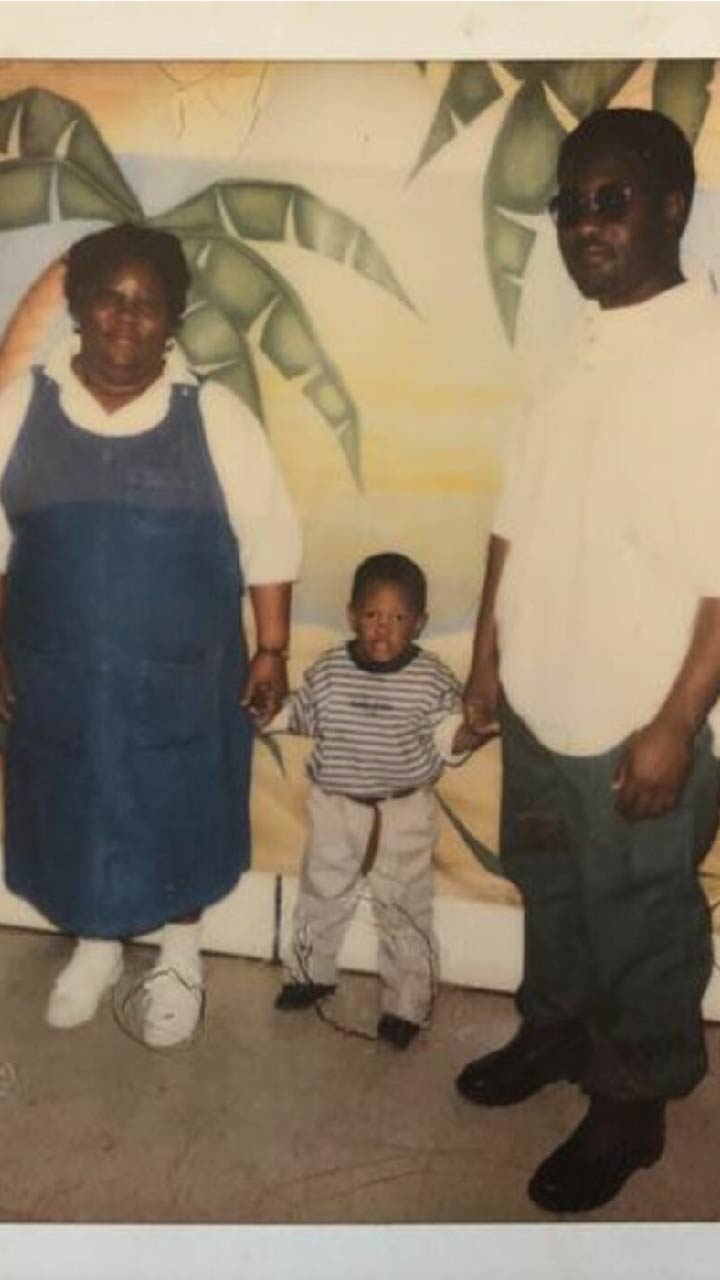
Caught in a whirlwind.
How a 17-year-old received 50-to-life for an arson he claims he did not commit.
December 17, 2021.
By Anna Deen.
Robert Webster had just turned 17 when he was arrested for firebombing a drug witness’s home at the height of the crack epidemic in 1987.
Convicted as a juvenile, he was sentenced 50-to-life for causing minor burns and property damage after the arson was linked, in the public eye, to the subsequent assassination of a young police officer.
Having maintained his innocence since the day of his arrest, Webster is applying for clemency with the hopes of reuniting with his family.
“I’m hoping that Governor Hochul will take into consideration my claim of wrongful conviction, my actual innocence claim; my age at the time; the amount of years that I have in prison; the accomplishments that I’ve done over the years,” Webster said in an interview at Green Haven Correctional Facility.
In 1987, a man, going by the single name of Arjune, bought a house in Jamaica, Queens, a few blocks from Webster’s home.
Crack was devastating southeastern Queens.
“When the crack epidemic hit, it was so fast and swift that you really didn’t see the neighborhood decline,” said Webster’s childhood friend Shawn Mazique. “You just woke up one day and the damage was done.”
That November, Arjune called the cops to report local drug dealing, resulting in an arrest.
Around 4:30 a.m. the following morning, two men threw Molotov cocktails at Arjune’s home, causing several small fires that the family extinguished. Police reports said the damage was “not severe.”
Almost two hours later, the house was firebombed again by two men, who drove up in a beige Chevrolet with two others in the car. The family called 911, saying Arjune “suffered light burns.” The fire marshal reported no further damage to the house.
An around-the-clock police detail was soon stationed in front of the home as a precaution.
Police arrested Webster the next day.
Initially, officers picked Webster up in a car and brought him to Arjune’s house, where family member Herrick Khan, who was present during the firebombings, said Webster was not the perpetrator. The officers let him go.
Webster hadn’t walked far before the officers pulled up in their car again. “Now this time...Herrick Khan is sayin’ it's me,” said Webster.
The officers arrested him.
No physical evidence linked Webster to the crime: Investigators found no fingerprints on the firebombs and did not test Webster’s clothing for gasoline.
Eyewitness accounts from Arjune and Khan were inconsistent, and there were missteps in identifying perpetrators.
The same day that Webster was arrested, Arjune and officers drove around and found a car that Arjune thought was the same beige Chevrolet he’d seen the day before. The officers confirmed the car owner’s alibi and didn’t pursue him as a suspect. The next month, Arjune identified a third perpetrator, but was later unable to pick the same man out of a police line-up.
At trial, Arjune's testimony placed Webster at the scene of the second arson, contradicting the sergeant’s earlier statement saying the family “did not see a perp.”
Joseph Justiz, Webster’s defense attorney, did not present this call or alibi witnesses at trial.
Today, eyewitness testimony is known to be unreliable.
In a high profile case in late 2021, the 55-year-old convictions of Muhammad A. Aziz and Khalil Islam — two men found guilty of assassinating Malcolm X in 1965 — were overturned by Manhattan District Attorney Cy Vance.
Aziz and Islam had been convicted despite no physical evidence tying either man to the crime scene or murder, and seven to 10 contradictory eyewitness testimonies.
According to data from the National Registry of Exonerations at the University of Michigan Law School, mistaken witness identification has been a contributing factor in about 28 percent of the 2,932 cases overturned in the United States since 1989.
In New York state, mistaken witness identification has contributed to about 34 percent of 328 exonerations.
Nationally, mistaken witness identification is disproportionately a factor in 36 percent of exonerations with a Black defendant. “The simplest explanation for this racial disparity is probably also the most powerful: the perils of cross-racial identification,” the National Registry of Exonerations said in a 2012 report.
In 2018, New York state revised jury instruction around instances of cross-racial identification, where a witness’s identification of a defendant of another race is in question, in light of People v. Boone.
Since the first wave of exonerations by DNA evidence in the 1990s, 25 states have implemented police line-up reforms to increase accuracy of eyewitness identification.
Crack-related violence climaxed the morning of Feb. 26, 1988, when assassins, later tied to dealer Howard “Pappy” Mason, shot and killed 22-year-old N.Y.P.D. officer Edward Byrne while he guarded Arjune’s home.
“An alarming 60 percent of murders in southeast Queens were ‘directly the result of narcotics problems,’” the New York Times reported shortly after the murder.
Webster, meanwhile, was in Rikers Island Jail.
Frenzied media coverage, often linking Webster to the killing, drew national attention.
President Ronald Reagon personally called the Byrne family to offer condolences while George H.W. Bush carried Byrne’s badge during his 1988 presidential campaign, prompting his lifelong relationship with the Byrne family.
Byrne’s assassination also led to a financial “crackdown on drug gangs,” the New York Daily News reported. As president, Bush established the Byrne Justice Program to fund the Department of Justice’s drug investigations and takedowns.
Decades later, the magnitude of Byrne’s death reverberates and is memorialized through an annual vigil.
After Byrne’s murder, everything just started going quickly, Webster said. Justice Thomas Demakos raised Webster’s bail from $15,000 to $100,000.
“I just [got] caught in this whirlwind,” Webster said. “That's when I realized that it was no longer just...a regular arson case.”
Webster was already well acquainted with the horrific effects of fires: Seven months before the firebombing took place, Webster’s two-year-old niece was killed in an accidental house fire.
“That’s one of the reasons why I have empathy for the Arjune family — because my family suffered from a terrible fire where we lost our niece,” he said. “It hurts me even more to think that somebody would think I would put their family through something like that, what we went through,” he said.
Webster was tried for both bombings and convicted in August 1988. His co-defendant, Johnson, who both Webster and he said met at arraignment, was convicted of the first bombing and released on parole in 2020.
At sentencing, Demakos referred to Byrne’s murder and crack’s endemic violence.
“I have been in this criminal justice system for over 25 years,” Demakos said, “and this is probably the most shocking crime of all, the use of violence and force against witnesses in our criminal justice system. It reminds me of the drug kingpins in South America.”
Demakos sentenced 17-year-old Webster to two consecutive 25-years-to-life sentences for the two attacks, double the prison terms handed to the four men convicted of killing Byrne, who each received 25-to-life. Arjune, who has since died, and his family went into witness protection.
“It was very traumatic for my whole family,” said Webster’s sister Vanessa Webster, herself barely a teenager at the time.
She had felt optimistic, she said, because she believed in her brother’s innocence and knew he had witnesses and an alibi: “I thought it was actually going to be in his favor.”
Demakos had discretion to elect, within a range of years, the maximum sentence, said Nayeon Kim, a City University of New York Law School student, who worked on Webster’s clemency application. “Because of the recent death of the cop, ...we think that...the judge was biased, the prosecutor was biased,” she said.
“There was a lot of media attention already in the context of the eighties, because of the so-called ‘war on drugs,'” said Kim. “Within that context, [Robert Webster’s] case fit into that in a way the prosecutor could frame another young Black man as someone who...looked like he might be a criminal based on how he looked like all these other people being arrested for drug convictions.”
Vanessa Webster said that because she lived in the same neighborhood where the events took place, she would hear neighbors talking about the news. “I would try to kind of block it out of my mind,” she said, “but it was just shocking.”
“I knew it was serious when it affected my dad,” she added.
Shortly after the arson, Webster’s father, Bobby, approached Arjune three times about dropping charges against his son, whom he’d insisted was innocent. Webster’s father was charged with witness tampering and harassment on Nov. 22, 1987.
According to the prosecution, when Arjune wouldn’t discuss the case, Bobby made “threatening remarks or gestures,” a Daily News article from Feb. 27, 1988 reported. Acting Justice Anthony P. Savarese sentenced Webster’s father, who’d had no prior arrests, to five-years probation for a count of third-degree witness tampering.
“As parents, they thought that they was doing the best that they could,” Vanessa Webster said. “He figured that he was doing something good and it actually turned out bad.”
Not really knowing the justice system impacted the family, she said. “We thought that by Robert taking this on, that he would actually win the trial — and he didn’t.”
Vanessa Webster is still processing the likelihood that her brother will spend the rest of his life in jail.
In New York state, because prisoners must serve the minimum sentence to be eligible for parole, Webster won’t be eligible for parole until 2037, at the age of 67.
According to a State of New York’s Department of Corrections and Community Supervision report, “between 2009 and 2012, 81% or 404 of the inmate deaths were due to natural causes. Inmates who died of natural causes were, on average, 57 years old at the time of death.”
New York’s Raise the Age legislation changed the ages at which juveniles could be tried as adults to 17 and 18 in 2018 and 2019, respectively, with some exceptions. Prior to the passage of this law, New York was one of only two states holding 16 year olds criminally responsible.
Laws like Raise the Age or sentencing reform laws, which deem certain kinds of sentences excessive for minors, generally don’t apply retroactively, said Kim. “It’s not very forgiving.”
Kim added that “clemency is a good venue...because the executive office is not bound to what the courts are bound to — and the courts are limited to whether statutes and legislation say that things like race and age can apply to people in the past.”
In 1992, Webster transferred to Green Haven Correctional Facility to be closer to his family, who remain a strong support system.
It was there that Sandra O’Connell, a former civilian employee with the New York State Department of Corrections and Community Supervision at Green Haven, met Webster when she worked, for six months or so, in the commissary, where he was assigned to collect orders a couple of hours a day — a job reserved for select few on honor block.
“He was always very interested in becoming better and expanding his horizons and looking towards the positive,” she said.
“I always thought that was ... the worst case of injustice that I had seen, and I was around a lot of inmates for a long period of time,” said O’Connell. “Here they were keeping this person who had no criminal record before, was in this [place] for this long and has a family to go home to.”
She added, “For him to remain the decent human being that he is and still maintain hope, is just amazing to me.”
Webster credits his ability to remain optimistic to his family, and particularly his father, with whom he had an especially close relationship. “My father played an important role in reminding me who I am and where I've come from,” he said.
Webster said his father, a welder, passed along family values by the example he set.
“I spent some of the best moments in my life in dirty basements, watching my father weld boilers,” Webster said. “He was trying to instill some work ethics in me that I know that I didn't really understand at that time,” he added.
Webster said he wished his younger self had listened to positive role models, and today he strives to be just that for Vanessa’s only son, Jawan, who was a year old when they met almost 25 years ago.
Their relationship has evolved over the years, with Webster having passed along the values his father instilled in him and some life advice of his own.
“He just tries to pull out the best in everybody,” Vanessa Webster said.
“I’m not saying that he replaced the love that my father had, but it is as meaningful as the relationship I had with my father,” Webster said. “It really, really feels good to know that you developed a relationship like this.”
Webster added, “I treasure that, because he’s like the son that I don’t have.”
If granted clemency, Webster wants to continue along that path of mentorship by joining the Credible Messenger Justice Center to guide at-risk youth. “A lot of these kids don't even know their rights, and that's something I want to get into,” he said, reflecting on his own experience.
While in prison, Webster earned his G.E.D, associate’s degree from Dutchess Community College and certificates across disciplines, including one in religious studies and another in A.I.D.S. counseling and education.
His motivation to pursue higher education in part came from wanting to tell his own story. He said he hopes to continue his paralegal studies on the outside.
Above all else, Webster wants to reunite with his family.
“We can’t bring back all the years that he missed,” said his sister, “but I am optimistic. I’m just leaving it in God’s hand.”
Webster’s father, Bobby, visited him nearly every weekend for 30 years until he died of cancer in 2017. “My incarceration, I think, hurt him more than anybody else in my family,” Webster said.
The first thing Webster hopes to do is visit his father’s grave.
“I want to be able to go to that grave and let him rest in peace,” he said. “Let him know I made it home.”